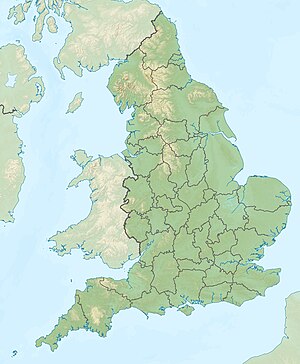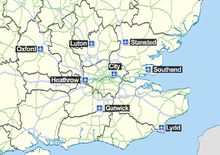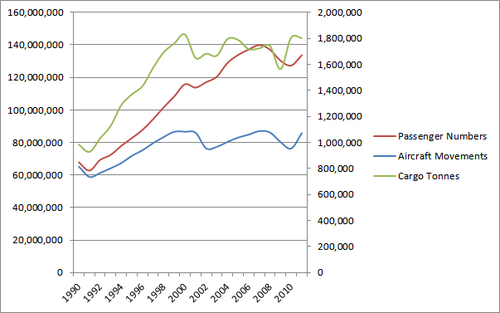
Heathrow Airport, called London Airport until 1966, is the main international airport serving London, the capital of England and the United Kingdom. It is the largest of the six international airports in the London airport system. The airport is owned and operated by Heathrow Airport Holdings, owned mostly by Qatar Investment Authority, Public Investment Fund and CDPQ. In 2023, Heathrow was the busiest airport in Europe, the fourth-busiest airport in the world by passenger traffic and the second-busiest airport in the world by international passenger traffic. As of 2023, Heathrow is the airport with the most international connections in the world.

London Stansted Airport is the tertiary international airport serving London, the capital of England and the United Kingdom. It is located near Stansted Mountfitchet, Essex, 42 mi (68 km) northeast of Central London.
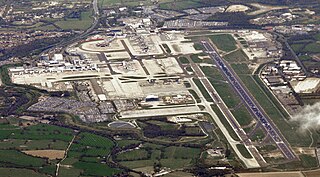
London Gatwick, also known as Gatwick Airport, is the secondary international airport serving London, the capital of England and the United Kingdom. It is located near Crawley, West Sussex, England 29.5 miles (47.5 km) south of Central London. In 2022, Gatwick was the second-busiest airport by total passenger traffic in the UK, after Heathrow Airport, and was the 8th-busiest in Europe by total passenger traffic. It covers a total area of 674 hectares.

London Southend Airport is a minor international airport situated on the outskirts of Southend-on-Sea in Essex, England, approximately 36 miles (58 km) from the centre of London. The airport straddles the boundaries between the city of Southend-on-Sea and the Rochford District.
Heathrow Airport Holdings is the United Kingdom-based operator of Heathrow Airport. The company also operated Gatwick Airport, Stansted Airport, Edinburgh Airport and several other UK airports, but was forced by the Competition Commission to sell them in order to break up a monopoly. It was formed by the privatisation of the British Airports Authority as BAA plc as part of Margaret Thatcher's moves to privatise government-owned assets, and was once a constituent of the FTSE 100 Index.

London has an extensive and developed transport network which includes both public and private services. Journeys made by public transport systems account for 37% of London's journeys while private services accounted for 36% of journeys, walking 24% and cycling 2%,according to numbers from 2017. London's public transport network serves as the central hub for the United Kingdom in rail, air and road transport.
The London Terminal Control Centre (LTCC) was an air traffic control centre based in West Drayton, in the London Borough of Hillingdon, England, approximately 2.5 miles (4.0 km) north of London Heathrow Airport. Operated by National Air Traffic Services (NATS) it provided air traffic control services to aircraft arriving and departing from six London airports, one Royal Air Force station, plus en-route services to other aircraft that entered its airspace. Internally within NATS it is usually known by the initials TC. The civilian part of the West Drayton site closed in November 2007, when its functions moved to Swanwick, Hampshire. 'TC' and 'AC' remain separate organisations but now share the same site.
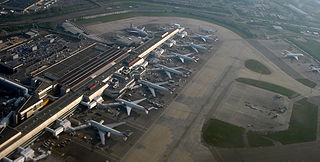
Air transport in the United Kingdom is the commercial carriage of passengers, freight and mail by aircraft, both within the United Kingdom (UK) and between the UK and the rest of the world. In the past 25 years the industry has seen continuous growth, and the demand for passenger air travel in particular is forecast to increase from the current level of 236 million passengers to 465 million in 2030. One airport, Heathrow Airport, is amongst the top ten busiest airports in the world. More than half of all passengers travelling by air in the UK currently travel via the six London area airports. Outside London, Manchester Airport is by far the largest and busiest of the remaining airports, acting as a hub for the 20 million or so people who live within a two-hour drive. Regional airports have experienced the most growth in recent years, due to the success of low-cost carrier airlines over the last decade.

The London Area Control Centre (LACC) is an air traffic control centre based at Swanwick near Fareham in Hampshire, southern England. It is operated by National Air Traffic Services (NATS), starting operations on 27 January 2002, and handles aircraft over much of England and Wales. The Swanwick facility replaces that of the former site at West Drayton.

A potential Thames Estuary Airport has been proposed at various times since the 1940s. London's existing principal airports, Heathrow, Gatwick, Stansted, and Luton are each sub-optimally located in various ways, such as being too close to built-up areas or requiring aircraft to fly low over London. In the case of Heathrow, the growth of air traffic has meant that the airport is operating at 98% capacity. Several locations for a new airport have been proposed in the Thames Estuary, to the east of London. These include Maplin Sands off Foulness on the north side of the estuary; Cliffe and the Isle of Grain in Kent on the south side; and artificial islands located off the Isle of Sheppey such as the "Boris Island" proposal championed by Boris Johnson, the then Mayor of London. Economic considerations have so far ruled out a new coastal airport, while political considerations have ruled out a new inland airport, leaving planners with an as-yet-unresolved dilemma.

Heathrow Central bus station is a large bus station that serves terminals 2 and 3 of Heathrow Airport, in London, England. It provides urban bus and long-distance coach services to destinations in London and to regional destinations across Britain. It is the UK's busiest bus and coach station with over 1,600 services each day to over 1,000 destinations. An estimated 13% of air passengers using Heathrow Airport use bus and coach services from Heathrow Central bus station.

Hounslow Heath Aerodrome was a grass airfield, operational 1914–1920. It was in the London borough of Hounslow, and hosted the British Empire's first scheduled daily international commercial flights, in 1919. The site today includes the main remaining part of Hounslow Heath.

The Great West Aerodrome, also known as Harmondsworth Aerodrome or Heathrow Aerodrome, was a grass airfield, operational between 1930 and 1944. It was on the southeast edge of the hamlet of Heathrow, in the parish of Harmondsworth. The Fairey Aviation Company owned and operated it, for assembly and flight testing of Fairey-manufactured aircraft. The area was to later be the site of London Heathrow Airport.
Airport policing in the United Kingdom has taken many forms since the rise of scheduled airline services in the post-war period. Policing at major civilian airports was the responsibility of specialist constabularies operated by three central government departments until 1974, when the rise in international terrorism saw armed police from territorial police forces deployed to major airports under the provisions of the Policing of Airports Act. As more minor airports grew in size, they too switched to armed police provided by local police forces. However, the funding agreements for the provision of such services varied wildly from airport to airport, leading to disagreements between airport operators and chief constables. A new regime, the Airport Security Planning Framework, came into force in January 2010, and brought airport operators, airlines and police forces together to develop joint security and policing plans for all passenger airports.

Heathwick is an informal name for a 2011 proposal to create a high-speed rail link between London's Heathrow and Gatwick airports, in effect to combine them into a single aviation travel hub. Proponents argue this would balance their capacity and so reduce the need to add more runways to Heathrow, or more airports in the south-east of England. In 2018 the similar project HS4Air was proposed.
The expansion of Gatwick Airport has involved several proposals aimed at increasing airport capacity in south east England and relieving congestion at the main hub airport Heathrow.
Gatwick Airport was in Surrey until 1974, when it became part of West Sussex as a result of a county boundary change. The original, pre-World War II airport was built on the site of a manor in the parish of Charlwood. The land was first used as an aerodrome in the 1920s, and in 1933 commercial flights there were approved by the Air Ministry.
